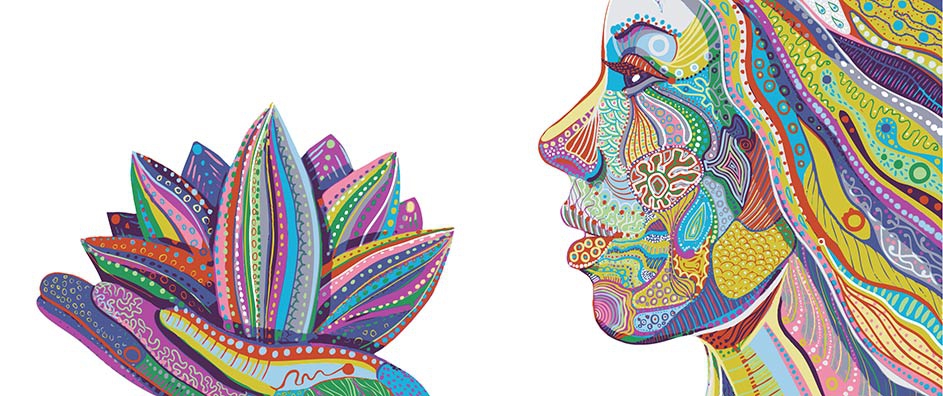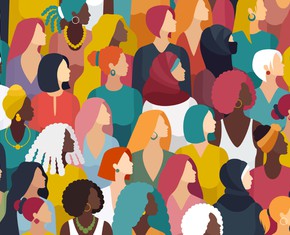The views expressed in our content reflect individual perspectives and do not represent the authoritative views of the Baha'i Faith.
Have you ever received a card in the mail that spoke to you—became a saver? I have several. My favorite: a postcard with a picture of a bird carrying a heavy burden—a boulder—strapped to its back. The poem below it reads:
a flightless bird called Faith
began to carry boulders:
for years she took these weights
strapped between her shoulders; and as you might expect
the sweat poured like a fountain,
but only time can tell
if Faith can move a mountain.
There’s probably not one of us who hasn’t carried boulders around at some time in our life. For many years, the boulders I moved from place to place were big weights that blocked my identity. Oh, yes, I was Jaine, the wife, mom, daughter, friend. But if I took away the husband, parents, friends, etc., I wasn’t sure just who would remain—if I’d want to spend time alone with her—and if I did, whether I’d like her. I felt lost and spiritually bankrupt.
The Baha’i teachings direct us to seek spiritual sustenance through daily prayer, meditation and study of scripture. When I took that advice to heart and began to study the Baha’i Writings in earnest, I discovered something that formed a turning point in my life: the arts are a key to spiritual transformation.
Artists have always known this, and many of those moved by art have at least suspected it. But never before has any religious text so clearly stated it. The Baha’i teachings contain a vast number of references that relate to the arts and their connection to spiritual growth.
I learned that the source of art, the inspiration for the artist, comes from the realm on high: from the original light radiated by the prophets, and from the souls who remain firm and unwavering in their faith before moving on to the next plane of existence.
The Baha’i teachings view the station of art quite differently than general society does—they actually equate art with worship:
If a man engages with all his power in the acquisition of a science or the perfection of an art, it is as if he has been worshiping God in the churches and temples. – Abdu’l-Baha, Selections from the Writings of Abdu’l-Baha, p. 144.
For Baha’is, art also contributes an important service to humanity:
What bounty greater than this that science should be considered as an act of worship and art as service to the Kingdom of God. – Ibid., p. 144.
Art is a gift:
All Art is a gift of the Holy Spirit. When this light shines through the mind of a musician, it manifests itself in beautiful harmonies. Again, shining through the mind of a poet, it is seen in fine poetry and poetic prose. When the Light of the Sun of Truth inspires the mind of a painter, he produces marvelous pictures. – Abdu’l-Baha, quoted in Lady Blomfield’s The Chosen Highway, p. 167.
Why? Baha’u’llah, the prophet and founder of the Baha’i Faith, explains:
…the true worth of artists and craftsmen should be appreciated, for they advance the affairs of mankind. – Baha’u’llah, from a tablet translated from the Persian.
How powerful to realize that artists and craftsmen “advance the affairs of mankind.”
The Baha’i writings also say that the arts will, if managed with propriety,
…become the means of sociability and affinity, and sociability and affinity themselves tend to guide others to the truth. – Abdu’l-Baha, Baha’i World Faith, p. 377.
How is this possible? How does it work? A few excerpts from the Baha’i writings provide some explanation:
Endeavor your utmost to compose beautiful poems to be chanted with heavenly music; thus may their beauty affect the minds and impress the hearts of those who listen. – Abdu’l-Baha, Tablets of Abdu’l-Baha, Volume 1, p. 59.
They go on and on, from music:
…although music is a material affair, yet its tremendous effect is spiritual, and its greatest attachment is to the realm of the spirit. – Abdu’l-Baha, “Table Talk,” quoted in Herald of the South, January 13, 1933, pp. 2-3.
to drama:
The drama is of the utmost importance. It has been a great educational power in the past; it will be so again. – Abdu’l-Baha, Abdu’l-Baha in London, p. 93.
The stage will be the pulpit of the future. – Abdu’l-Baha, quoted by Loulie Mathews in The Magazine of the Children of the Kingdom, June 1923.
to visual arts and literature:
Writing is, in itself, a sign of the writer’s soul and intelligence. – Abdu’l-Baha, Paris Talks, p. 91.
to architecture and all other areas of the arts:
It is natural for the heart and spirit to take pleasure and enjoyment in all things that show forth symmetry, harmony, and perfection. For instance: a beautiful house, a well designed garden, a symmetrical line, a graceful motion, a well written book, pleasing garments — in fact, all things that have in themselves grace or beauty are pleasing to the heart and spirit — therefore, it is most certain that a true voice causes deep pleasure. – Abdu’l-Baha, as quoted in “A Brief Account of My Visit to Acca,” pp. 11-14.
After finding all of these references to art in the Baha’i teachings, I took them to heart. They served as the emotional calisthenics that helped me develop my spiritual muscles—which allowed me to keep moving those boulders around in my search for my identity, my spiritual reality.
















Comments
Sign in or create an account
Continue with Googleor